Influencing Factors and Risk Assessment of Precipitation-Induced Flooding in Zhengzhou, China, Based on Random Forest and XGBoost Algorithms
Abstract
:1. Introduction
2. Materials and Methods
2.1. Overview of the Study Area
2.2. Research Methods
2.2.1. GIS-Weighted Integrated Evaluation Method
2.2.2. Random Forest
2.2.3. XGBoost
2.2.4. Accuracy and the Area under the Curve
2.3. Data Sources
2.3.1. Flooded Areas
2.3.2. Assessment Indicators
3. Results
3.1. Flood Risk Assessment Index Analysis and Optimisation
Analysis of Indicator Contributions Using RF
3.2. Optimisation of Flood Risk-Assessment Indicators
Optimisation of Assessment Indicators
3.3. Precipitation-Induced Flooding Risk Assessment
Assessment Indicator Weighting
3.4. Assessment Results and Analysis
3.4.1. Analysis of Individual Assessment Results
3.4.2. Analysis of Assessment Results
4. Discussion
4.1. Risk-Assessment Framework of Storm and Flooding Based on Four Indicators of Precipitation-Induced Flooding Risk
4.2. Strategies for Risk Management of Storm and Flood Disasters and Urban Planning in Zhengzhou
5. Conclusions
Author Contributions
Funding
Institutional Review Board Statement
Informed Consent Statement
Data Availability Statement
Conflicts of Interest
References
- Dano, U.L.; Balogun, A.-L.; Matori, A.-N.; Wan Yusouf, K.; Abubakar, I.R.; Said Mohamed, M.A.; Aina, Y.A.; Pradhan, B. Flood susceptibility mapping using GIS-based analytic network process: A case study of Perlis, Malaysia. Water 2019, 11, 615. [Google Scholar] [CrossRef] [Green Version]
- Saha, A.; Pal, S.C.; Arabameri, A.; Blaschke, T.; Panahi, S.; Chowdhuri, I.; Chakrabortty, R.; Costache, R.; Arora, A. Flood susceptibility assessment using novel ensemble of hyperpipes and support vector regression algorithms. Water 2021, 13, 241. [Google Scholar] [CrossRef]
- Costache, R.; Pham, Q.B.; Sharifi, E.; Linh, N.T.T.; Abba, S.I.; Vojtek, M.; Vojteková, J.; Nhi, P.T.T.; Khoi, D.N. Flash-flood susceptibility assessment using multi-criteria decision making and machine learning supported by remote sensing and GIS techniques. Remote Sens. 2019, 12, 106. [Google Scholar] [CrossRef] [Green Version]
- Wu, Z.; Shen, Y.; Wang, H. Assessing urban areas’ vulnerability to flood disaster based on text data: A case study in Zhengzhou city. Sustainability 2019, 11, 4548. [Google Scholar] [CrossRef] [Green Version]
- Wu, Z.; Xue, W.; Xu, H.; Yan, D.; Wang, H.; Qi, W. Urban Flood Risk Assessment in Zhengzhou, China, Based on a D-Number-Improved Analytic Hierarchy Process and a Self-Organizing Map Algorithm. Remote Sens. 2022, 14, 4777. [Google Scholar] [CrossRef]
- Chapi, K.; Singh, V.P.; Shirzadi, A.; Shahabi, H.; Bui, D.T.; Pham, B.T.; Khosravi, K. A novel hybrid artificial intelligence approach for flood susceptibility assessment. Environ. Model. Softw. 2017, 95, 229–245. [Google Scholar] [CrossRef]
- Le, X.-H.; Ho, H.V.; Lee, G.; Jung, S. Application of long short-term memory (LSTM) neural network for flood forecasting. Water 2019, 11, 1387. [Google Scholar] [CrossRef] [Green Version]
- Tehrany, M.S.; Lee, M.-J.; Pradhan, B.; Jebur, M.N.; Lee, S. Flood susceptibility mapping using integrated bivariate and multivariate statistical models. Environ. Earth Sci. 2014, 72, 4001–4015. [Google Scholar] [CrossRef]
- Nachappa, T.G.; Piralilou, S.T.; Gholamnia, K.; Ghorbanzadeh, O.; Rahmati, O.; Blaschke, T. Flood susceptibility mapping with machine learning, multi-criteria decision analysis and ensemble using Dempster Shafer Theory. J. Hydrol. 2020, 590, 125275. [Google Scholar] [CrossRef]
- Song, Y.; Zhu, Z.; Qin, M. Prediction and Assessment of Rainstorm Flooding Disasters Risk in Shanghai Metropolitan Area in 2050. IOP Conf. Ser. Earth Environ. Sci. 2020, 510, 032006. [Google Scholar] [CrossRef]
- Ruidas, D.; Chakrabortty, R.; Islam, A.R.M.; Saha, A.; Pal, S.C. A novel hybrid of meta-optimization approach for flash flood-susceptibility assessment in a monsoon-dominated watershed, Eastern India. Environ. Earth Sci. 2022, 81, 1–22. [Google Scholar] [CrossRef]
- Ye, C.; Xu, Z.; Lei, X.; Liao, W.; Ding, X.; Liang, Y. Assessment of urban flood risk based on data-driven models: A case study in Fuzhou City, China. Int. J. Disaster Risk Reduct. 2022, 82, 103318. [Google Scholar] [CrossRef]
- Montesinos-Pedro, E.; Domínguez-Ramírez, N.; Montejano-Castillo, M. Flood risk in times of COVID-19, Peñón de los Baños, Venustiano Carranza, Mexico City, Mexico. Int. J. Environ. Impacts 2022, 5, 216–226. [Google Scholar] [CrossRef]
- Ruidas, D.; Pal, S.C.; Islam, A.R.M.; Saha, A. Characterization of groundwater potential zones in water-scarce hardrock regions using data driven model. Environ. Earth Sci. 2021, 80, 1–18. [Google Scholar] [CrossRef]
- Roy, P.; Pal, S.C.; Chakrabortty, R.; Chowdhuri, I.; Malik, S.; Das, B. Threats of climate and land use change on future flood susceptibility. J. Clean. Prod. 2020, 272, 122757. [Google Scholar]
- Ruidas, D.; Saha, A.; Islam, A.R.M.; Costache, R.; Pal, S.C. Development of geo-environmental factors controlled flash flood hazard map for emergency relief operation in complex hydro-geomorphic environment of tropical river, India. Environ. Sci. Pollut. Res. 2022, 1–16. [Google Scholar] [CrossRef] [PubMed]
- Hasanuzzaman, M.; Islam, A.; Bera, B.; Shit, P.K. A comparison of performance measures of three machine learning algorithms for flood susceptibility mapping of river Silabati (tropical river, India). Phys. Chem. Earth 2022, 127, 103198. [Google Scholar] [CrossRef]
- Pal, S.C.; Chowdhuri, I.; Das, B.; Chakrabortty, R.; Roy, P.; Saha, A.; Shit, M. Threats of climate change and land use patterns enhance the susceptibility of future floods in India. J. Environ. Manag. 2022, 305, 114317. [Google Scholar] [CrossRef]
- Ruidas, D.; Pal, S.C.; Saha, A.; Chowdhuri, I.; Shit, M. Hydrogeochemical characterization based water resources vulnerability assessment in India’s first Ramsar site of Chilka lake. Mar. Pollut. Bull. 2022, 184, 114107. [Google Scholar] [CrossRef]
- Ruidas, D.; Pal, S.C.; Islam, T.; Md, A.R.; Saha, A. Hydrogeochemical Evaluation of Groundwater Aquifers and Associated Health Hazard Risk Mapping Using Ensemble Data Driven Model in a Water Scares Plateau Region of Eastern India. Expo. Health 2022, 1–19. [Google Scholar] [CrossRef]
- Burn, D.H. Evaluation of regional flood frequency analysis with a region of influence approach. Water Resour. Res. 1990, 26, 2257–2265. [Google Scholar] [CrossRef]
- Schoppa, L.; Disse, M.; Bachmair, S. Evaluating the performance of random forest for large-scale flood discharge simulation. J. Hydrol. 2020, 590, 125531. [Google Scholar] [CrossRef]
- Chen, W.; Li, Y.; Xue, W.; Shahabi, H.; Li, S.; Hong, H.; Wang, X.; Bian, H.; Zhang, S.; Pradhan, B. Modeling flood susceptibility using data-driven approaches of naïve bayes tree, alternating decision tree, and random forest methods. Sci. Total Environ. 2020, 701, 134979. [Google Scholar] [CrossRef] [PubMed]
- Ma, M.; Zhao, G.; He, B.; Li, Q.; Dong, H.; Wang, S.; Wang, Z. XGBoost-based method for flash flood risk assessment. J. Hydrol. 2021, 598, 126382. [Google Scholar] [CrossRef]
- Feng, Q.; Liu, J.; Gong, J. Urban flood mapping based on unmanned aerial vehicle remote sensing and random forest classifier—A case of Yuyao, China. Water 2015, 7, 1437–1455. [Google Scholar] [CrossRef]
- Dong, R.; Zhang, X.; Li, H. Constructing the ecological security pattern for sponge city: A case study in zhengzhou, china. Water 2019, 11, 284. [Google Scholar] [CrossRef] [Green Version]
- Luo, J.; Zhai, S.; Song, G.; He, X.; Song, H.; Chen, J.; Liu, H.; Feng, Y. Assessing Inequity in Green Space Exposure toward a “15-Minute City” in Zhengzhou, China: Using Deep Learning and Urban Big Data. Int. J. Environ. Res. Public Health 2022, 19, 5798. [Google Scholar] [CrossRef]
- Xi, C.; Guo, Y.; He, R.; Mu, B.; Zhang, P.; Li, Y. The Use of Remote Sensing to Quantitatively Assess the Visual Effect of Urban Landscape—A Case Study of Zhengzhou, China. Remote Sens. 2022, 14, 203. [Google Scholar] [CrossRef]
- Zhou, S.; Liu, D.; Zhu, M.; Tang, W.; Chi, Q.; Ye, S.; Xu, S.; Cui, Y. Temporal and Spatial Variation of Land Surface Temperature and Its Driving Factors in Zhengzhou City in China from 2005 to 2020. Remote Sens. 2022, 14, 4281. [Google Scholar] [CrossRef]
- Li, H.; Wang, G.; Tian, G.; Jombach, S. Mapping and analyzing the park cooling effect on urban heat island in an expanding city: A case study in Zhengzhou city, China. Land 2020, 9, 57. [Google Scholar] [CrossRef] [Green Version]
- Lee, S.; Kim, J.-C.; Jung, H.-S.; Lee, M.J.; Lee, S. Spatial prediction of flood susceptibility using random-forest and boosted-tree models in Seoul metropolitan city, Korea. Geomat. Nat. Hazards Risk 2017, 8, 1185–1203. [Google Scholar] [CrossRef]
- Pal, S.C.; Ruidas, D.; Saha, A.; Islam, A.R.M.T.; Chowdhuri, I. Application of novel data-mining technique-based nitrate concentration susceptibility prediction approach for coastal aquifers in India. J. Clean. Prod. 2022, 346, 131205. [Google Scholar] [CrossRef]
- Deepak, S.; Rajan, G.; Jairaj, P. Geospatial approach for assessment of vulnerability to flood in local self governments. Geoenviron. Disasters 2020, 7, 1–19. [Google Scholar] [CrossRef]
- Abu El-Magd, S.A. Random forest and naïve Bayes approaches as tools for flash flood hazard susceptibility prediction, South Ras El-Zait, Gulf of Suez Coast, Egypt. Arab. J. Geosci. 2022, 15, 1–12. [Google Scholar] [CrossRef]
- Kim, H.I.; Kim, B.H. Flood hazard rating prediction for urban areas using random forest and LSTM. KSCE J. Civ. Eng. 2020, 24, 3884–3896. [Google Scholar] [CrossRef]
- Ghansah, B.; Nyamekye, C.; Owusu, S.; Agyapong, E. Mapping flood prone and Hazards Areas in rural landscape using landsat images and random forest classification: Case study of Nasia watershed in Ghana. Cogent Eng. 2021, 8, 1923384. [Google Scholar] [CrossRef]
- Band, S.S.; Janizadeh, S.; Chandra Pal, S.; Saha, A.; Chakrabortty, R.; Melesse, A.M.; Mosavi, A. Flash flood susceptibility modeling using new approaches of hybrid and ensemble tree-based machine learning algorithms. Remote Sens. 2020, 12, 3568. [Google Scholar] [CrossRef]
- Mobley, W.; Sebastian, A.; Blessing, R.; Highfield, W.E.; Stearns, L.; Brody, S.D. Quantification of continuous flood hazard using random forest classification and flood insurance claims at large spatial scales: A pilot study in southeast Texas. Nat. Hazards Earth Syst. Sci. 2021, 21, 807–822. [Google Scholar] [CrossRef]
- Abedi, R.; Costache, R.; Shafizadeh-Moghadam, H.; Pham, Q.B. Flash-flood susceptibility mapping based on XGBoost, random forest and boosted regression trees. Geocarto Int. 2022, 37, 5479–5496. [Google Scholar] [CrossRef]
- Costache, R.; Ali, S.A.; Parvin, F.; Pham, Q.B.; Arabameri, A.; Nguyen, H.; Crăciun, A.; Anh, D.T. Detection of areas prone to flood-induced landslides risk using certainty factor and its hybridization with FAHP, XGBoost and deep learning neural network. Geocarto Int. 2021, 1–36. [Google Scholar] [CrossRef]
- Madhuri, R.; Sistla, S.; Srinivasa Raju, K. Application of machine learning algorithms for flood susceptibility assessment and risk management. J. Water Clim. Chang. 2021, 12, 2608–2623. [Google Scholar] [CrossRef]
- Ghosh, S.; Saha, S.; Bera, B. Flood susceptibility zonation using advanced ensemble machine learning models within Himalayan foreland basin. Nat. Hazards Res. 2022. [Google Scholar] [CrossRef]
- Ekmekcioğlu, Ö.; Koc, K.; Özger, M.; Işık, Z. Exploring the additional value of class imbalance distributions on interpretable flash flood susceptibility prediction in the Black Warrior River basin, Alabama, United States. J. Hydrol. 2022, 610, 127877. [Google Scholar] [CrossRef]
- Hamidul Haque, M.; Sadia, M.; Mustaq, M. Development of Flood Forecasting System for Someshwari-Kangsa Sub-watershed of Bangladesh-India Using Different Machine Learning Techniques. EGU Gen. Assem. Conf. Abstr. 2021, EGU21-15294. [Google Scholar] [CrossRef]
- Díez-Herrero, A.; Garrote, J.J.W. Flood risk assessments: Applications and uncertainties. Water 2020, 12, 2096. [Google Scholar] [CrossRef]
- Michaelis, T.; Brandimarte, L.; Mazzoleni, M. Capturing flood-risk dynamics with a coupled agent-based and hydraulic modelling framework. Hydrol. Sci. J. 2020, 65, 1458–1473. [Google Scholar] [CrossRef]
- Brivio, P.; Colombo, R.; Maggi, M.; Tomasoni, R. Integration of remote sensing data and GIS for accurate mapping of flooded areas. Int. J. Remote Sens. 2002, 23, 429–441. [Google Scholar] [CrossRef]
- Kocornik-Mina, A.; McDermott, T.K.; Michaels, G.; Rauch, F. Flooded cities. Am. Econ. J. Appl. Econ. 2020, 12, 35–66. [Google Scholar] [CrossRef]
- Alho, C.J.; Silva, J.S. Effects of severe floods and droughts on wildlife of the Pantanal wetland (Brazil)—A review. Animals 2012, 2, 591–610. [Google Scholar] [CrossRef] [Green Version]
- Ireland, G.; Volpi, M.; Petropoulos, G.P. Examining the capability of supervised machine learning classifiers in extracting flooded areas from Landsat TM imagery: A case study from a Mediterranean flood. Remote Sens. 2015, 7, 3372–3399. [Google Scholar] [CrossRef] [Green Version]
- Minh, H.V.T.; Avtar, R.; Mohan, G.; Misra, P.; Kurasaki, M. Monitoring and mapping of rice cropping pattern in flooding area in the Vietnamese Mekong delta using Sentinel-1A data: A case of an Giang province. Int. J. Geo-Inf. 2019, 8, 211. [Google Scholar] [CrossRef]
- Barredo, J.I.; Engelen, G. Land use scenario modeling for flood risk mitigation. Sustainability 2010, 2, 1327–1344. [Google Scholar] [CrossRef] [Green Version]
- Rincón, D.; Khan, U.T.; Armenakis, C. Flood risk mapping using GIS and multi-criteria analysis: A greater Toronto area case study. Geosciences 2018, 8, 275. [Google Scholar] [CrossRef] [Green Version]
- Wang, Z.; Wang, H.; Huang, J.; Kang, J.; Han, D. Analysis of the public flood risk perception in a flood-prone city: The case of Jingdezhen city in China. Water 2018, 10, 1577. [Google Scholar] [CrossRef] [Green Version]
- Jonkman, S.N.; Dawson, R.J. Issues and challenges in flood risk management—Editorial for the special issue on flood risk management. Water 2012, 4, 785–792. [Google Scholar] [CrossRef] [Green Version]
- Thieken, A.H.; Kienzler, S.; Kreibich, H.; Kuhlicke, C.; Kunz, M.; Mühr, B.; Müller, M.; Otto, A.; Petrow, T.; Pisi, S.; et al. Review of the flood risk management system in Germany after the major flood in 2013. Ecol. Soc. 2016, 21, 51. [Google Scholar] [CrossRef]
- Shane, R.M.; Lynn, W.R. Mathematical model for flood risk evaluation. J. Hydraul. Div. 1964, 90, 1–20. [Google Scholar] [CrossRef]
- Chan, N.W. Increasing flood risk in Malaysia: Causes and solutions. Disaster Prev. Manag. Int. J. 1997. [Google Scholar] [CrossRef]
- Terpstra, T.; Gutteling, J.M. Households’ perceived responsibilities in flood risk management in the Netherlands. Int. J. Water Resour. Dev. 2008, 24, 555–565. [Google Scholar] [CrossRef]
- Demeritt, D.; Nobert, S. Models of best practice in flood risk communication and management. Environ. Hazards 2014, 13, 313–328. [Google Scholar] [CrossRef] [Green Version]
- Tsakiris, G. Flood risk assessment: Concepts, modelling, applications. Nat. Hazards Earth Syst. Sci. 2014, 14, 1361–1369. [Google Scholar] [CrossRef]
- Albano, R.; Sole, A.; Adamowski, J.; Perrone, A.; Inam, A. Using FloodRisk GIS freeware for uncertainty analysis of direct economic flood damages in Italy. Int. J. Appl. Earth Obs. Geoinf. 2018, 73, 220–229. [Google Scholar] [CrossRef]
- Yin, J.; Ye, M.; Yin, Z.; Xu, S. A review of advances in urban flood risk analysis over China. Stoch. Environ. Res. Risk Assess. 2015, 29, 1063–1070. [Google Scholar] [CrossRef]
- Taromideh, F.; Fazloula, R.; Choubin, B.; Emadi, A.; Berndtsson, R. Urban Flood-Risk Assessment: Integration of Decision-Making and Machine Learning. Sustainability 2022, 14, 4483. [Google Scholar] [CrossRef]
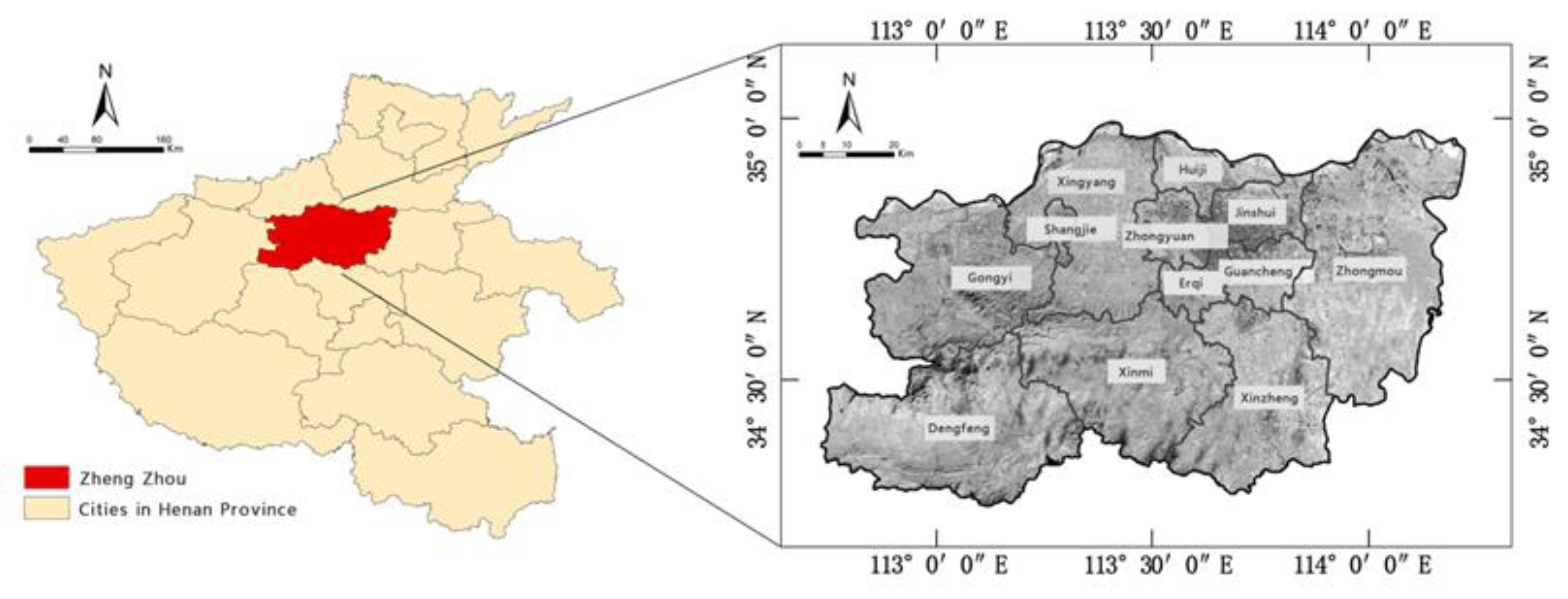

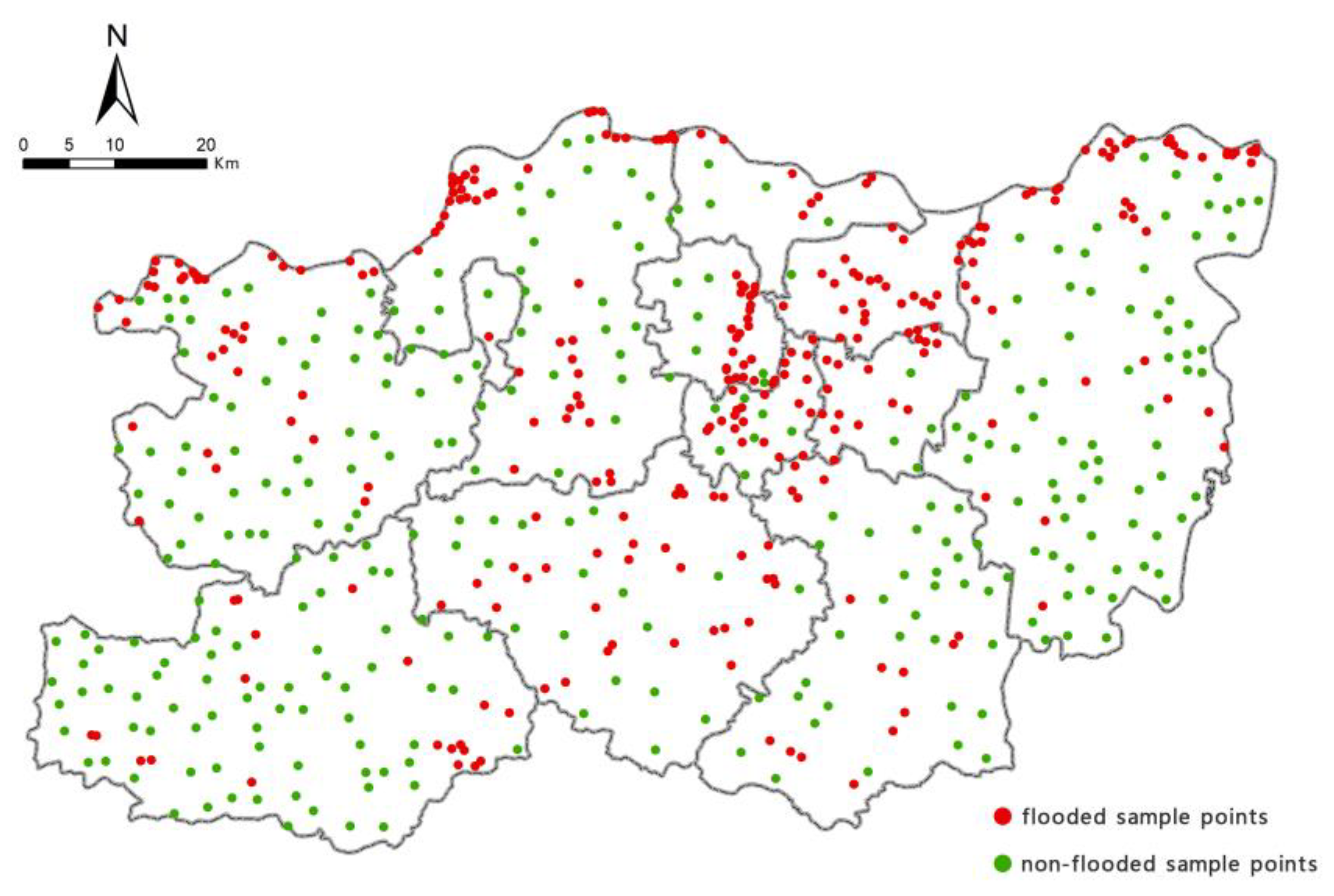

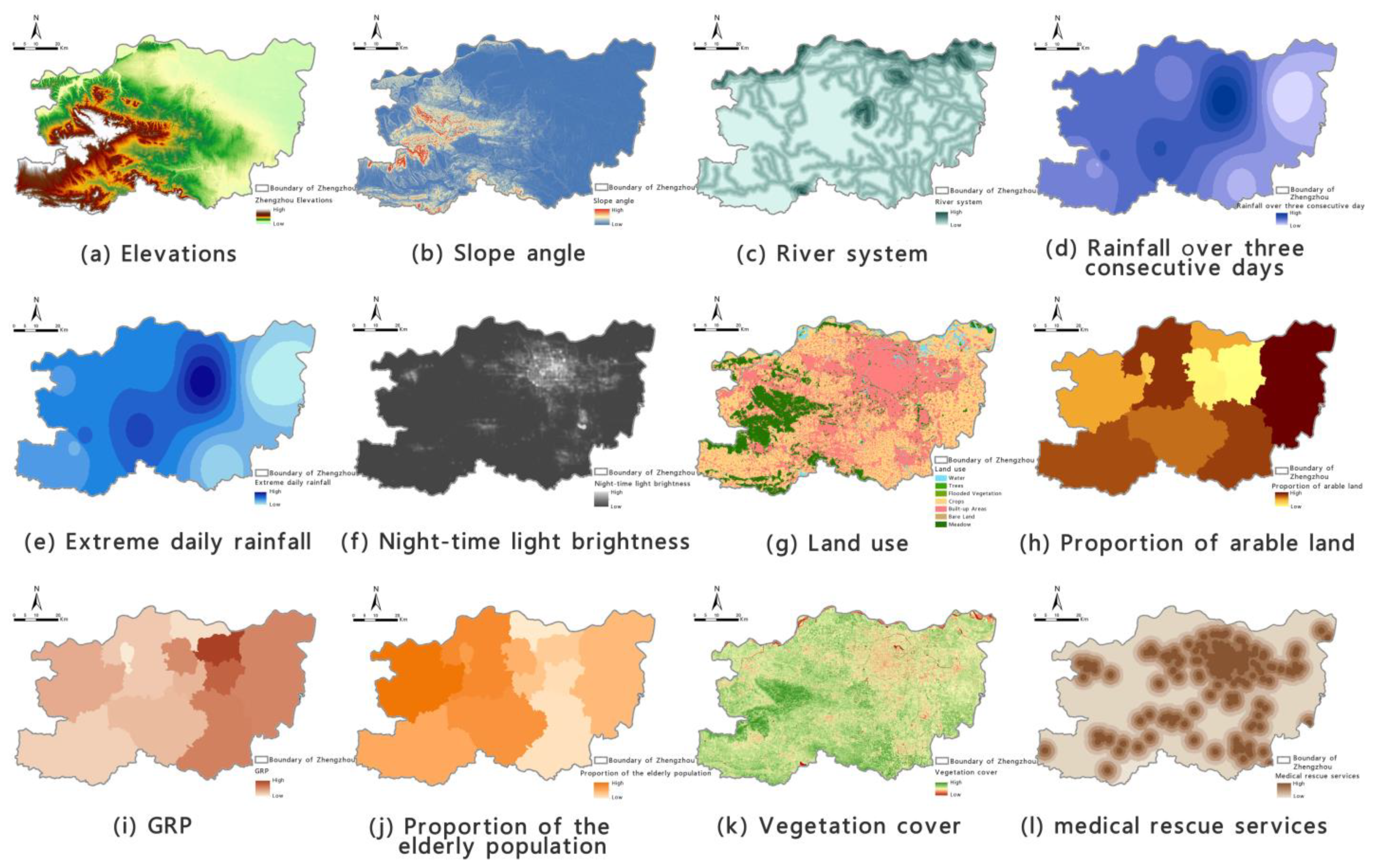

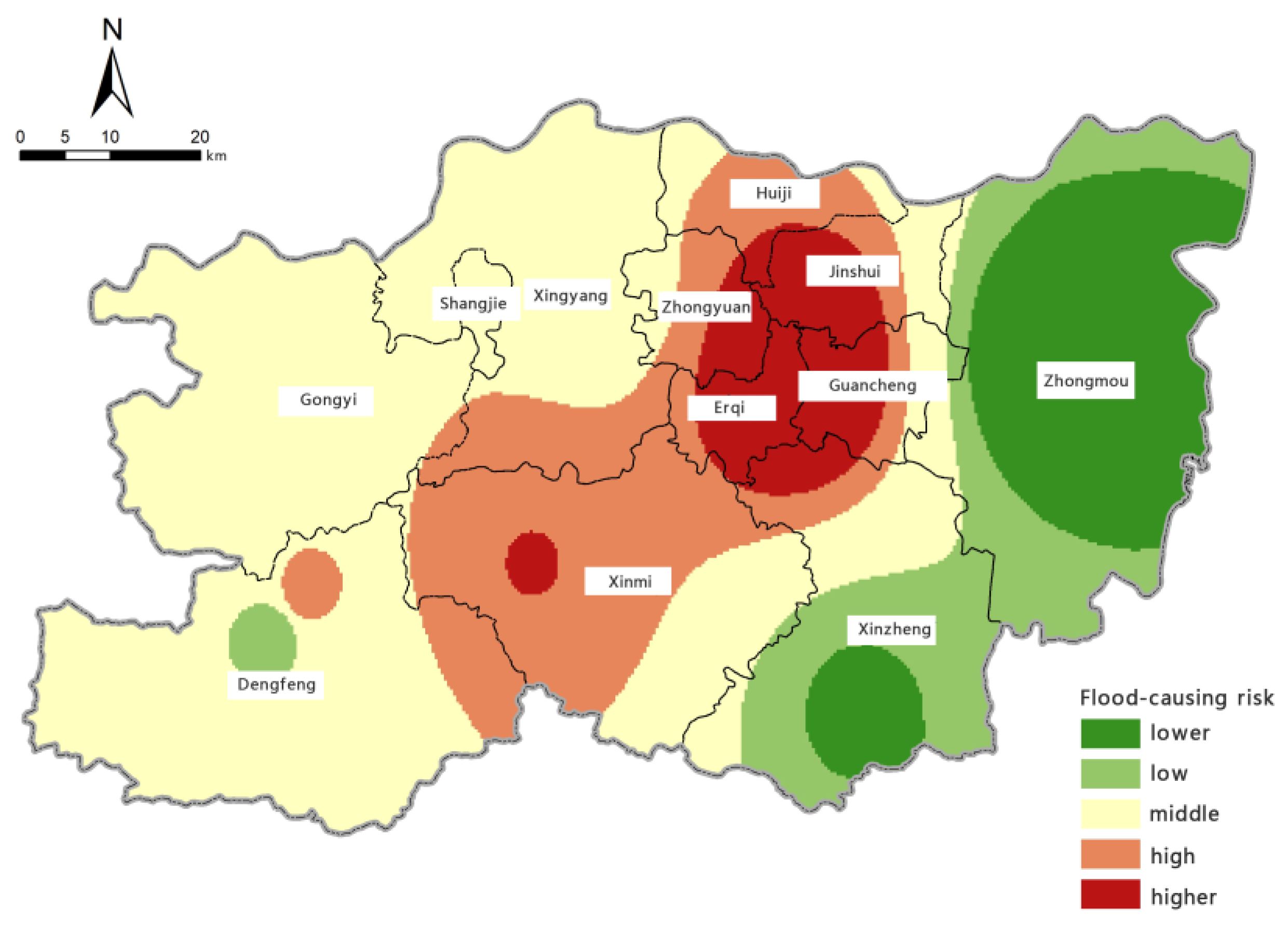

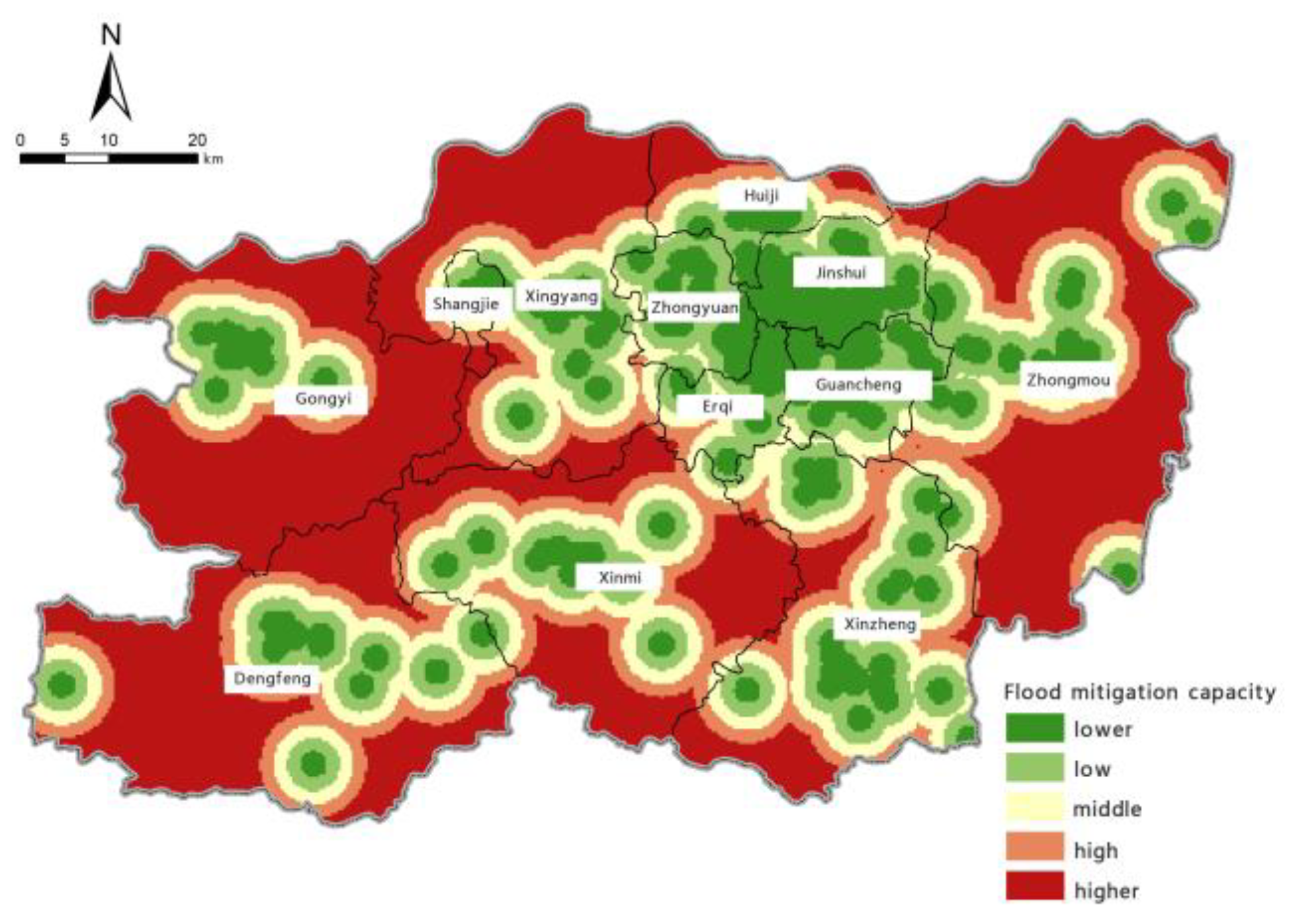

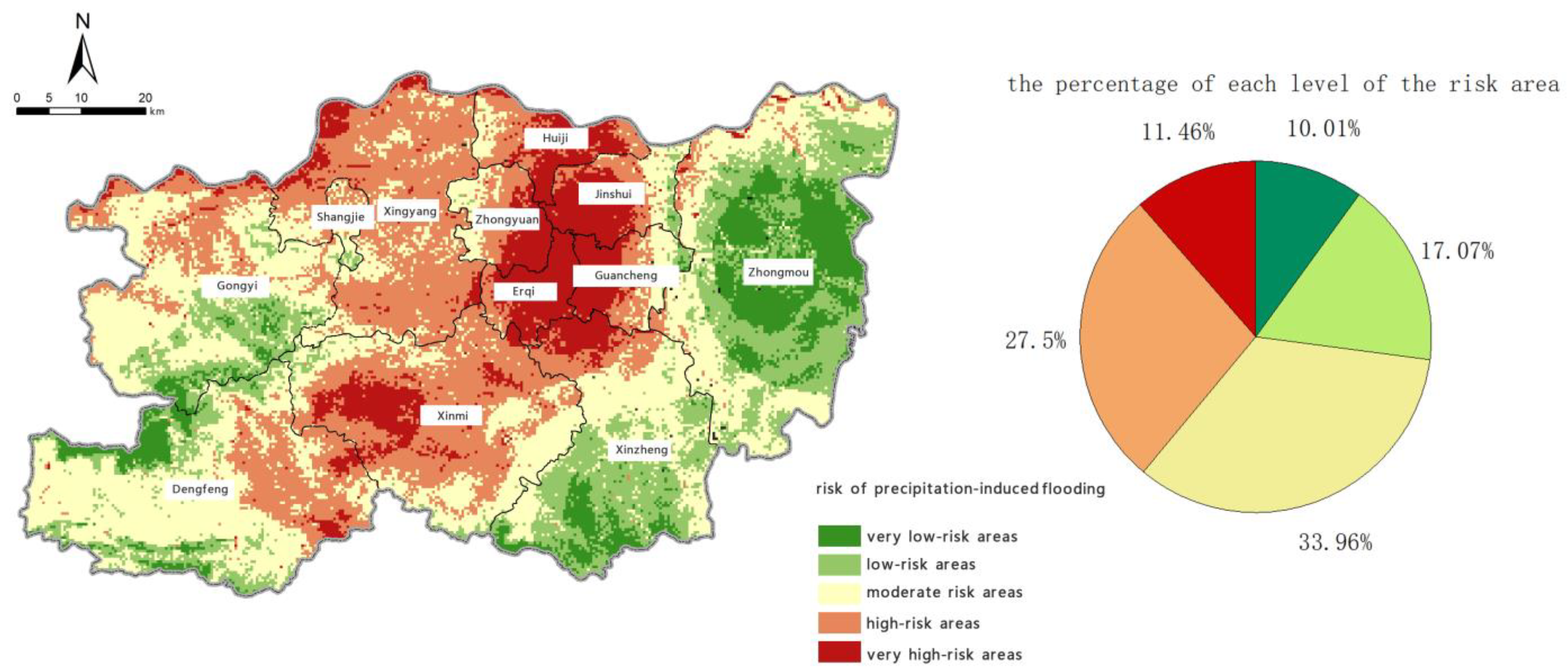
| Primary Indicators | Secondary Indicators | Data Sources |
|---|---|---|
| Flood-aggravating environmental susceptibility | Elevation | Geospatial Data Cloud |
| Slope angle | ||
| Slope aspect | ||
| River system | National Catalogue Service for Geographic Information-1:1 million national public basic geographic information data (2021) | |
| Roads | ||
| Flood-causing risk | 3-day rainfall | Data crawling from the National Meteorological Information Center |
| Extreme rainfall | ||
| Location-specific exposure | Night-time lights | Earth Observation Group of the National Centers for Environmental Information under the National Oceanic and Atmosphere Administration (US) |
| Land use | Esri, using Sentinel-2 remote sensing images combined with an AI land classification model | |
| Arable land | ||
| Gross regional product | Zhengzhou Municipal Bureau of Statistics | |
| Gross domestic product per capita | ||
| Economic growth | ||
| Elderly population | ||
| Vegetation cover | Calculated based on remote sensing data from the Landsat-8 satellite in 2021 | |
| Flood-mitigation capability | Medical rescue services | Data on general hospitals and 3A hospitals from Baidu Maps |
| Experiment | Deleted Indicator(s) | ACC | AUC |
|---|---|---|---|
| 1 | None | 0.880111 | 0.948667 |
| 2 | Economic growth | 0.889333 | 0.955333 |
| 3 | Economic growth, roads | 0.887667 | 0.961889 |
| 4 | Economic growth, roads, slope aspect | 0.906111 | 0.966333 |
| 5 | Economic growth, roads, slope aspect, GDP per capita | 0.913333 | 0.967111 |
| 6 | Economic growth, roads, slope aspect, GDP per capita, medical response | 0.900000 | 0.967333 |
| 7 | Economic growth, roads, slope aspect, GDP per capita, medical response, elderly population | 0.891111 | 0.962778 |
| 8 | Economic growth, roads, slope aspect, GDP per capita, medical response, elderly population, proportion of arable land | 0.887333 | 0.957667 |
| Target | Primary Indicators | Secondary Indicators | Weight | Indicator Type |
|---|---|---|---|---|
| Precipitation-induced flooding risk | Flood-aggravating susceptibility | (a) Elevation | 0.085 | Negative |
| (b) Slope angle | 0.054 | Negative | ||
| (c) River system | 0.096 | Positive | ||
| Flood-causing risk | (d) 3-day rainfall | 0.146 | Positive | |
| (e) Extreme daily rainfall | 0.188 | Positive | ||
| Location-specific exposure | (f) Night-time lights | 0.045 | Positive | |
| (g) Land use | 0.103 | Positive | ||
| (h) Arable land proportion | 0.064 | Positive | ||
| (i) GRP | 0.032 | Negative | ||
| (j) Elderly population | 0.020 | Positive | ||
| (k) Vegetation cover | 0.138 | Negative | ||
| Flood-mitigating capability | (l) Medical response | 0.028 | Negative |
Publisher’s Note: MDPI stays neutral with regard to jurisdictional claims in published maps and institutional affiliations. |
© 2022 by the authors. Licensee MDPI, Basel, Switzerland. This article is an open access article distributed under the terms and conditions of the Creative Commons Attribution (CC BY) license (https://creativecommons.org/licenses/by/4.0/).
Share and Cite
Liu, X.; Zhou, P.; Lin, Y.; Sun, S.; Zhang, H.; Xu, W.; Yang, S. Influencing Factors and Risk Assessment of Precipitation-Induced Flooding in Zhengzhou, China, Based on Random Forest and XGBoost Algorithms. Int. J. Environ. Res. Public Health 2022, 19, 16544. https://doi.org/10.3390/ijerph192416544
Liu X, Zhou P, Lin Y, Sun S, Zhang H, Xu W, Yang S. Influencing Factors and Risk Assessment of Precipitation-Induced Flooding in Zhengzhou, China, Based on Random Forest and XGBoost Algorithms. International Journal of Environmental Research and Public Health. 2022; 19(24):16544. https://doi.org/10.3390/ijerph192416544
Chicago/Turabian StyleLiu, Xun, Peng Zhou, Yichen Lin, Siwei Sun, Hailu Zhang, Wanqing Xu, and Sangdi Yang. 2022. "Influencing Factors and Risk Assessment of Precipitation-Induced Flooding in Zhengzhou, China, Based on Random Forest and XGBoost Algorithms" International Journal of Environmental Research and Public Health 19, no. 24: 16544. https://doi.org/10.3390/ijerph192416544




